Index
This topic area covers statistics and information relating to diet and nutrition among adults in Hull including local strategic need and service provision. Further information relating to Diet and Nutrition Among Children and Young People is given under Lifestyle Factors within Children and Young People. Diet information has been collected within Hull’s Health and Wellbeing Surveys and full reports are available under Surveys within Tools and Resources. Further information relating to children eligible for free school meals can be found under Schools, Education and Qualifications and information relating to food insecurity (concerns over being able to provide food for the family) can be found under Financial Resilience both under Health and Wellbeing Influences.
This page contains information from the Office for Health Improvement & Disparities’ Fingertips. Information is taken ‘live’ from the site so uses the latest available data from Fingertips and displays it on this page. As a result, some comments on this page may relate to an earlier period of time until this page is next updated (see review dates at the end of this page).
Headlines
- Poor diet has been linked to several types of cancers, and can increase the risk of hypertension and cardiovascular disease. It also can have an impact on malnutrition, as well as overweight and obesity.
- Fewer people in Hull eat five portions of fruit and vegetables (5-A-DAY) and diets are poorer in Hull than England. There is a strong association between 5-A-DAY and both age and deprivation with diets better among older people and those living in the least deprived areas. High levels of deprivation increase the barriers to a healthy diet, through reduced access to fresh fruit and vegetables, knowledge about diet and cooking, and financial barriers. Hull also has a high number of takeaways.
- From the Access to Healthy Assets and Hazards index, all areas of Hull are within a five minute drive of the nearest fast food outlet with the majority of residents within a couple of minutes drive away. Whilst not all residents have access to cars, this illustrates the density of fast food outlets in the city within a short walk away. Furthermore, there will be a high number of options for fast food home delivery available for residents.
- Hull has developed a whole-system approach to promoting a healthy weight which considers the multi-factorial drivers of overweight and obesity and involves transformative co-ordinated action across a broad range of disciplines and stakeholders. Hull is recognised nationally as a bronze Sustainable Food City, which is led locally by the Hull Food Partnership.
The Population Affected – Why Is It Important?
Poor diet has been linked to several types of cancer including cancer of the bowel, stomach, breast, lung, prostate, pancreas, oesophagus and bladder. A diet high in fat and salt is also a risk factor for cardiovascular disease as fatty build-ups within the arteries can cause heart attacks, stroke and other cardiovascular events. Salt increases the risk of hypertension which is also a risk factor for cardiovascular disease.
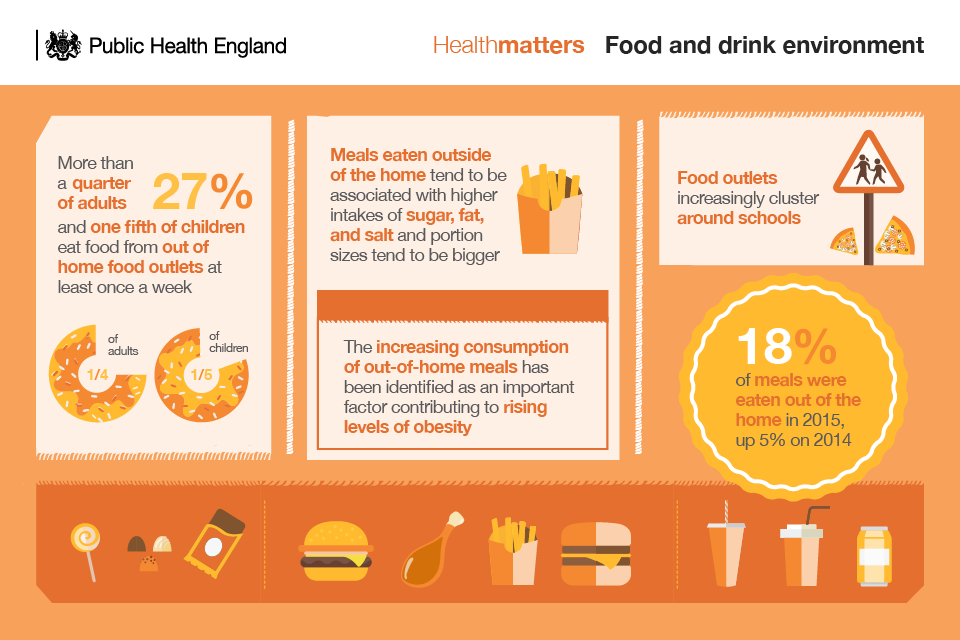
A poor diet can lead to overweight or malnourishment.
Around one in three people admitted to hospital or care homes in the UK are found to be malnourished or at risk of malnourishment, which can be caused by an inadequate diet or a health problem leading to the body being unable to absorb all the nutrients it needs from food.
In more deprived areas, access to good quality fruit and vegetables, reliance of public transport which restricts ability to buy heavy fruit and vegetables and cost issues are barriers to eating a well-balanced diet. A lack of cooking skills and knowledge can also be a barrier to eating a balanced diet.
In 2005, it was estimated that food related ill health is responsible for about 10% of morbidity and mortality in the UK.
Clearly there are strong associations between diet, physical activity and obesity, but they are also all independent risk factors for poor health. In 2006/07, the cost of the NHS in the UK was estimated to be £5.8 billion for poor diet-related ill health, £0.9 billion for physical inactivity, and £5.1 billion for overweight and obesity. In 2014/15, the estimated costs for overweight and obesity to the NHS had risen to £6.1 billion (with a total cost of £27 billion to the wider society).
In the National Food Strategy: An Independent Review for Government published in 2019, it was stated that the government spends an estimated £18 billion (8% of all government healthcare expenditure) on conditions related to high body mass index every year, and that this was before diet-related disease not linked to weight was taken into account. In 2019/20, there were just over one million hospital admissions where obesity was recorded as the primary or secondary diagnosis – a 17% increase on 2018/19. They state that the Organisation of Economic Co-operation and Development estimates that the combined costs of conditions related to a high body mass index, in lost workforce productivity, reduction in life expectancy and NHS funds, is £74 billion every year. This is equivalent to cutting the UK’s Gross Domestic Product (GDP) by 3.4%. Again this does not account for cost associated with diet-related disease not linked to weight.
The Hull Picture
Healthy Diet and Knowledge Around What Constitutes A Healthy Diet
Within the local adult Health and Wellbeing Survey 2019, survey responders were asked if they ate a healthy diet or not. They could select the responses: yes; no; don’t know what a healthy diet is; or don’t know if I have a healthy diet.
Overall 63% stated that they ate a healthy diet, but there was considerable variation by gender, across the age groups, by local deprivation fifth, by employment and by household composition. Women were more likely to state they had a healthy diet. Only 44% of 16-24 year olds stated they had a healthy diet and this increased successively by age with those aged 75+ years having almost double the percentage who stated they ate a healthy diet. Just over a half of people living in the most deprived fifth of areas of Hull state they ate a healthy diet but this was almost three-quarters among those living in the least deprived fifth of areas of Hull. People who were retired, working or looking after the home or family were the most likely to have a healthy diet.
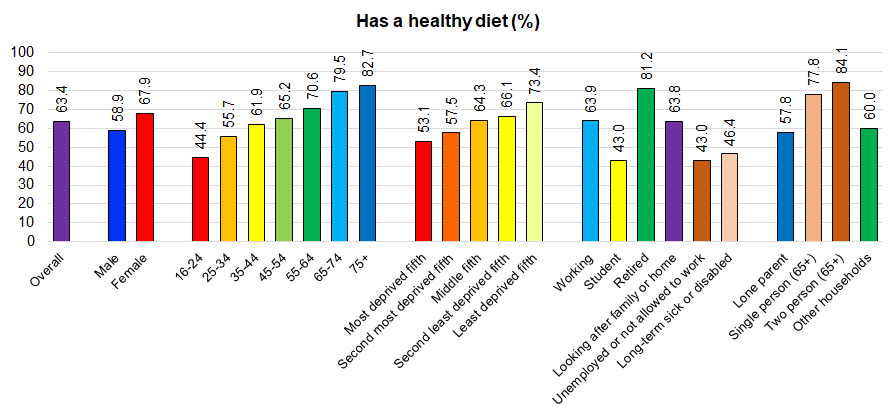
There was a wide variation across Hull’s 21 electoral wards in relation to the percentage stating they ate a healthy diet. Over eight in ten of the survey responders who lived in Bricknell stated they ate a healthy diet, but in contrast fewer than six in ten stated they did so in North Carr, Beverley & Newland, Orchard Park, University, Longhill & Bilton Grange, and Marfleet.
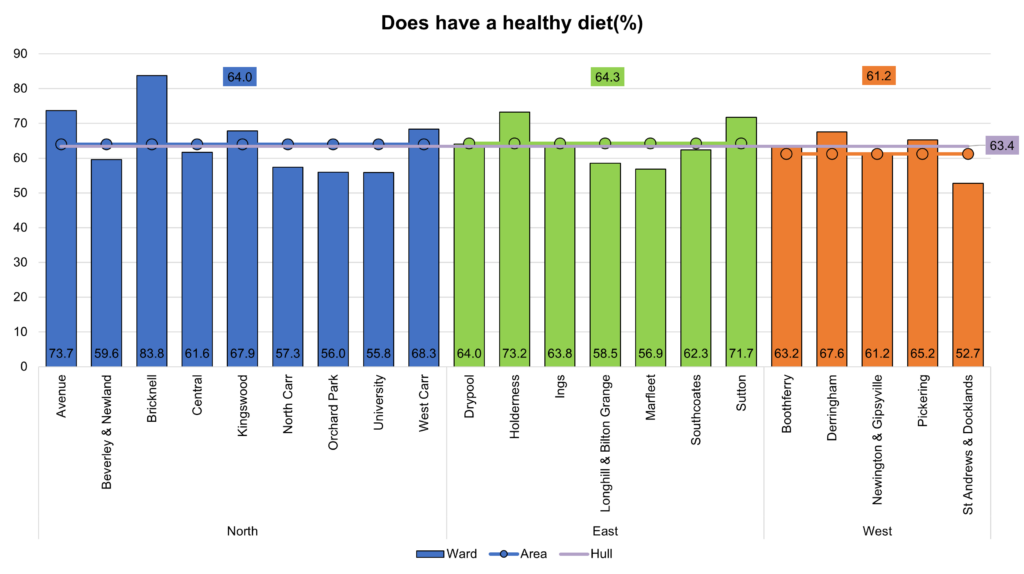
Just over one-quarter stated that they did not eat a healthy diet, but this was much higher among young people, people living in the most deprived areas of Hull, students, people who were unemployed or not working due to long-term illness or disability were more likely to state they did not eat a healthy diet as were lone parents.
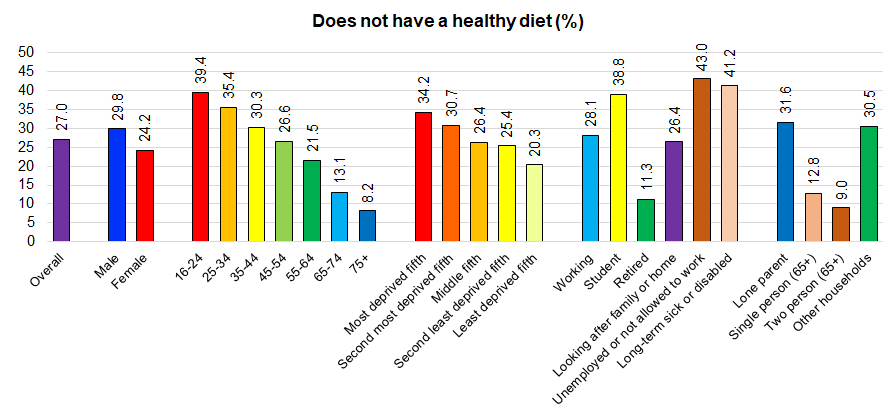
One-third or more of survey responders living in Orchard Park, University and Marfleet stated they did not eat a healthy diet.
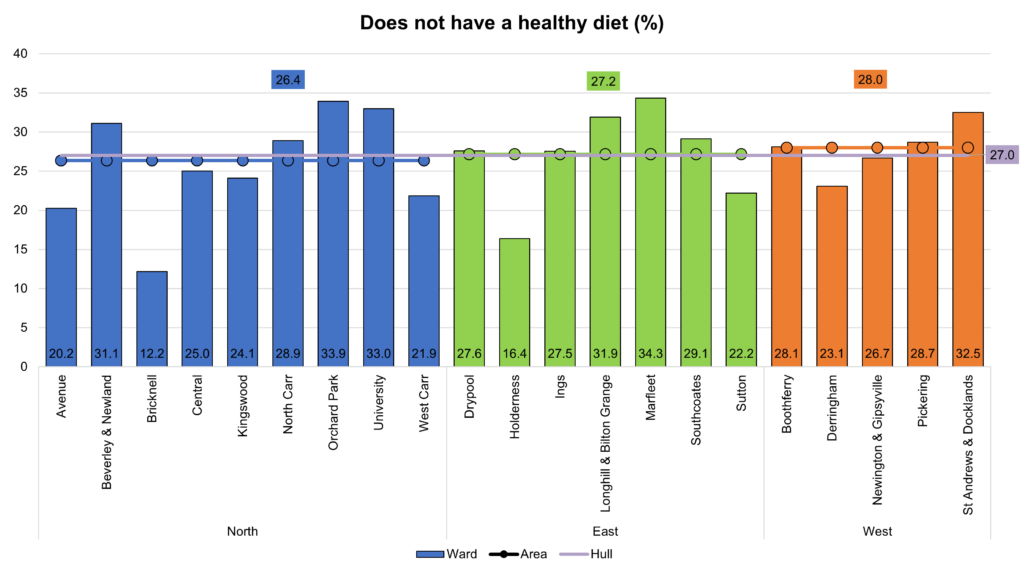
Around one in ten reported a lack of knowledge about what constituted a healthy diet (Combining the two “don’t know” responses). Men, those aged 16-24 years, people living in the most deprived areas of Hull, students, people who were unemployed or not working due to long term illness or disability, and lone parents were the most likely to have a lack of knowledge of what constituted a healthy diet.
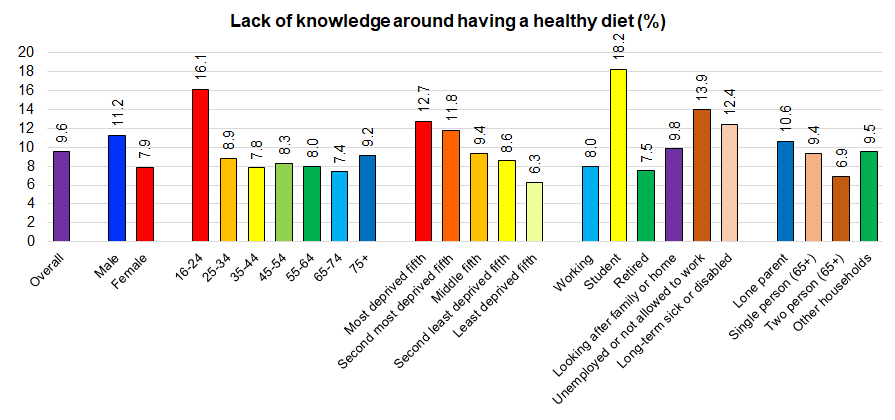
People in North Carr, Newington & Gipsyville, St Andrew’s & Docklands and Central were the most likely to have a lack of knowledge around what constituted a healthy diet.
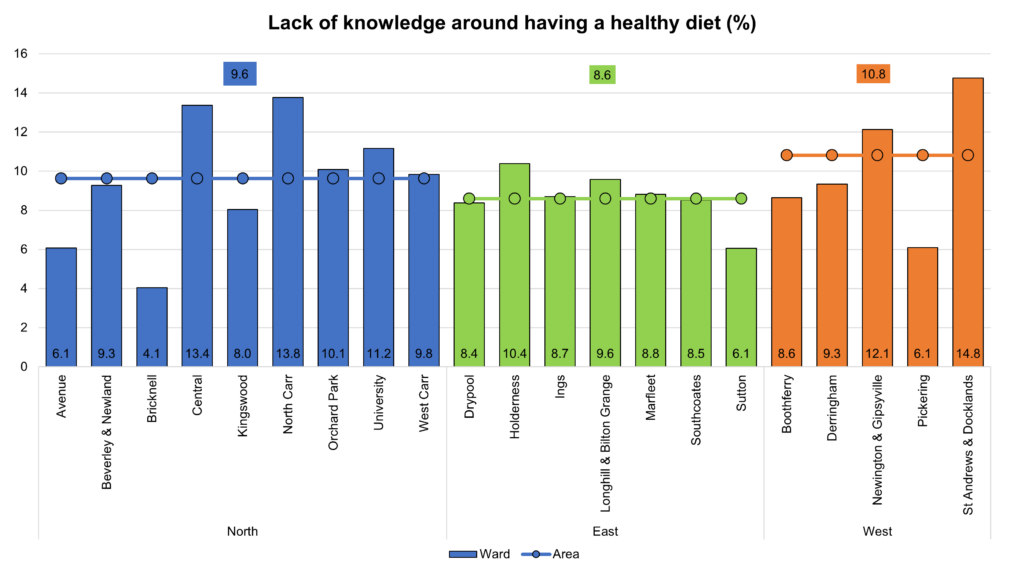
5-A-DAY – Daily Portions of Fruits and Vegetables
Survey responders were also asked the number of portions of fruits and vegetables they generally ate each day with examples of what constituted a portion. Around one in five ate five or more portions of fruits and vegetables per day, but it differed considerably by gender, age, deprivation and employment status. Men, young people, people living in the most deprived two-fifths of arears of Hull, students, people who were unemployed, people who were not working due to long-term illness or disability, and lone parents were the least likely to eat 5-A-DAY.
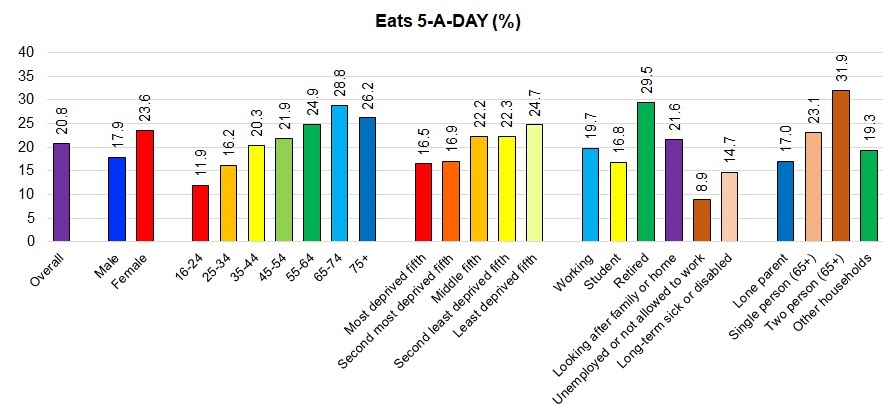
There were considerable difference across Hull’s 21 electoral wards. Only 15-16% of all survey responders living in Kingswood, Longhill & Bilton Grange, St Andrew’s & Docklands, and Central stated they ate 5-A-DAY. It was perhaps a surprise that the figure was so low in Kingswood ward as this is one of the least deprived wards in Hull, but Kingswood tends to have a relatively young population compared to other wards in Hull and it is possible that this could be influential.
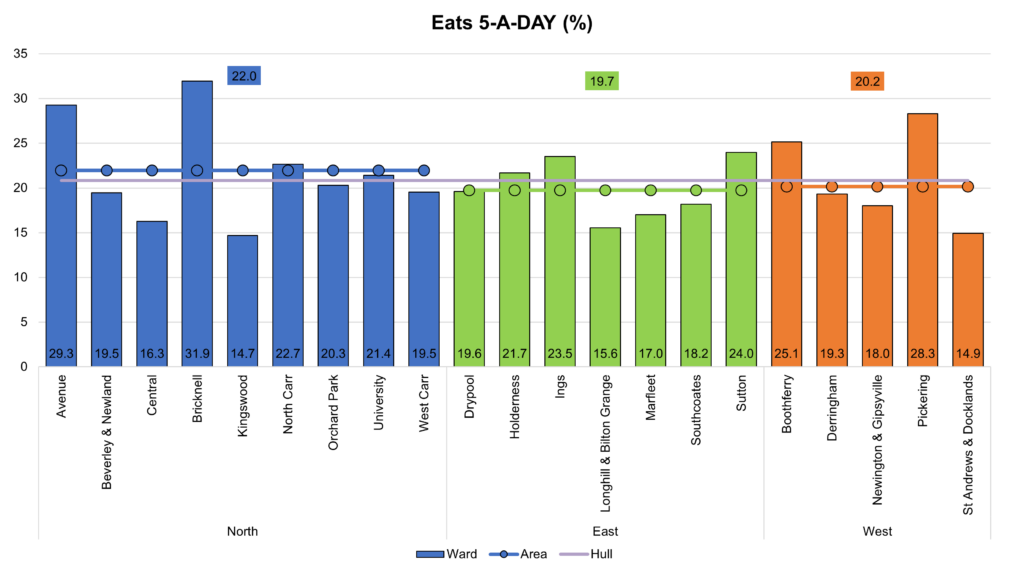
From local surveys, the prevalence of 5-A-DAY has remained relatively unchanged over time at around 20%, but the percentage eating no or few (0-2) portions of fruit and vegetables has increased over time. Thus people in Hull appear to be eating fewer portions of fruits and vegetables. The survey in 2009 involved an interview rather than a self-completion questionnaire so this might explain why the percentages reporting 5-A-DAY is slightly higher in 2009. The percentage reporting that they eat a healthy diet has decreased from around 70% or more (74% in 2007, 79% in 2009, 71% in 2011 and 69% in 2014) to 63% in the latest survey. Thus it appears that people’s diets have deteriorated over time in Hull with a reduction in fruit and vegetable consumption and fewer people stating they eat a healthy diet, although it is possible that people’s opinion or perception of what constitutes a healthy diet has changed which influences whether they state they are eating a healthy diet or not.
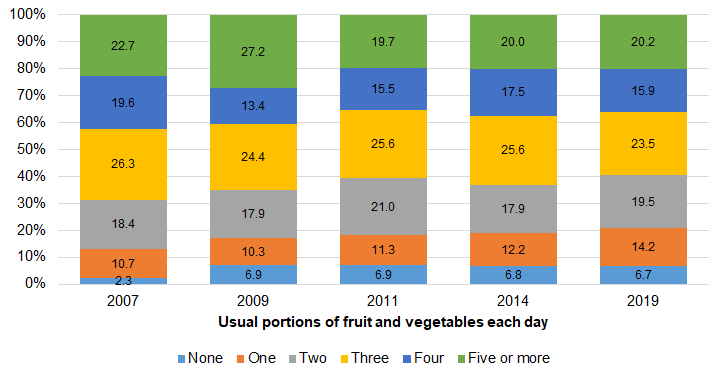
From the Health Survey for England 2018, it was estimated that 28% of people in England eat 5-A-DAY, although estimates from the Active Lives Survey (previously published on The Office for Health Improvement & Disparities’ Fingertips) completed by Sport England were much higher at 55% for England and 44% for Hull for 2019/20. The estimate for 5-A-DAY for Hull from the Active Lives Survey is also much higher – more than twice as high – than the local survey at 44% for 2019/20.
However, the questions have been reformulated within the Active Lives Survey and are now closer to local estimates from Hull’s Health and Wellbeing Survey conducted during 2019 with an estimate of 27.5% for Hull from the national survey for 2022/23. However, despite the estimates now being closer to the local survey, there is still a considerable difference of 6.7 percentage points or 32% (as the estimate from the local survey was 20.8%). Whilst the questions in both surveys are now similar, the methodology of these local and national surveys are quite different, and it is likely that the local survey provides a more accurate estimate of 5-A-DAY in Hull. The local survey involved more than 4,000 survey responders throughout Hull which were representative of Hull’s population in terms of age, gender and geography. However, there are fewer than 500 survey responders who take part in the Active Lives Survey who live in Hull, and furthermore due to the way the survey is administered it is possible that those that do respond and participate are not representative of Hull’s population.
Compared with benchmark
Recent trends
| Indicator | Period | England | Yorkshire and the Humber region (statistical) | Kingston upon Hull | East Riding of Yorkshire | North East Lincolnshire | North Lincolnshire | York | North Yorkshire UA | Barnsley | Doncaster | Rotherham | Sheffield | Bradford | Calderdale | Kirklees | Leeds | Wakefield |
|---|---|---|---|---|---|---|---|---|---|---|---|---|---|---|---|---|---|---|
Percentage of adults meeting the '5-a-day' fruit and vegetable consumption recommendations (new method) (Persons 16+ yrs) | 2022/23 | 31.0 | 29.6 | 27.5 | 35.7 | 27.4 | 27.8 | 32.6 | 37.2 | 29.4 | 31.0 | 31.0 | 29.7 | 26.1 | 28.6 | 26.9 | 28.3 | 20.4 |
| Indicator | Period | England | Yorkshire and the Humber region (statistical) | Kingston upon Hull | East Riding of Yorkshire | North East Lincolnshire | North Lincolnshire | York | North Yorkshire UA | Barnsley | Doncaster | Rotherham | Sheffield | Bradford | Calderdale | Kirklees | Leeds | Wakefield |
|---|---|---|---|---|---|---|---|---|---|---|---|---|---|---|---|---|---|---|
Percentage of adults meeting the '5-a-day' fruit and vegetable consumption recommendations (new method) (Persons 16+ yrs) | 2022/23 | 31.0 | 29.6 | 27.5 | 35.7 | 27.4 | 27.8 | 32.6 | 37.2 | 29.4 | 31.0 | 31.0 | 29.7 | 26.1 | 28.6 | 26.9 | 28.3 | 20.4 |
As the question has changed within the Active Lives Survey, it is not possible to compare the trends over time prior to 2020/21.
Between 2020/21 and 2022/23, the Active Lives Survey reports two consecutive increases in the percentage of Hull’s adults who ate eating five or more portions of fruits and vegetables.
Compared with benchmark
Recent trends
Percentage of adults meeting the '5-a-day' fruit and vegetable consumption recommendations (new method) (Persons 16+ yrs)
|
Period
|
Kingston upon Hull |
Yorkshire and the Humber region (statistical)
|
England
|
||||
|---|---|---|---|---|---|---|---|
|
Count
|
Value
|
95%
Lower CI |
95%
Upper CI |
||||
| 2020/21 | • | - | 24.0% | 20.1% | 28.0% | 33.8% | 34.9% |
| 2021/22 | • | - | 26.9% | 22.9% | 30.9% | 30.5% | 32.5% |
| 2022/23 | • | - | 27.5% | 23.4% | 31.6% | 29.6% | 31.0% |
Source: OHID, based on Sport England data
Also from the adult Health and Wellbeing Survey 2019, 8.7% worried about not having enough food to eat ‘most days’ or ‘about once a week’ due to lack of money or other resources (this equates to around 9,200 adults in Hull worrying most days and a further 9,000 worrying about once a week). Slightly higher percentages worried about being unable to eat healthy and nutritious food due to lack of money or other resources (10.6%). Further information is available on Financial Resilience under Health and Wellbeing Influences.
Takeaways in Local Area
Within local qualitative projects, participants always mentioned the excessive a number of takeaways in their local area. “I was terrible for it, takeaways everywhere. Temptation. I mean, I live across the road from a takeaway and it’s lovely and I wish it wasn’t there. I’m glad it’s there, but I wish it wasn’t there. It’s a kebab, pizza, Turkish takeaway. And within ten minutes’ walk, there’s four of that type, a couple of chicken places, two Chinese, an Indian, three chip shops, these are all in less than ten minute walk and I live in a council estate near the University”.
In 2014, Hull had a very high number of fast food outlets per 100,000 population and the highest in the Yorkshire and Humber region as measured from one of the indicators on the Office for Health Improvement Disparities’ Fingertips. However, the indicator had not been updated for a decade and has now been removed from Fingertips. There is a planning restriction to restrict new hot food takeaway applications from opening up with 400 metres of a secondary school or playing field in Hull over the last few years and this has reduced the number of hot foot takeaways by at least 40 over the last few years.
The Access to Healthy Assets and Hazards index has been updated in 2024 and this includes more up-to-date information on fast food outlets based on the drive time to the nearest fast food outlet.
The Access to Healthy Assets and Hazards (AHAH) index is designed to allow policy and decision makers to understand which areas have poor environments for health, and to help move away from treating features of the environment in isolation.
The Access to Healthy Assets and Hazards index is comprised of four domains: access to retail services (fast food outlets, gambling outlets, pubs/bars/nightclubs, off licences, tobacconists), access to health services (GP surgeries, A&E hospitals, pharmacies, dentists and leisure centres), the physical environment (green and blue spaces) and levels of air pollution (nitrogen dioxide (NO2), particulate matter smaller than 10 microns (PM10) and sulphur dioxide (SO2)).
In 2024, the Access to Healthy Assets and Hazards Index is very high in Hull with 44.7% of Hull’s population residing in the bottom fifth of areas nationally in relation to the Access to Healthy Assets and Hazards Index. The percentage nationally is 20.9% and across the other 14 lower tier local authorities in the region the range is from 1.3% to 32.6%.
Compared with benchmark
| Indicator | Period | England | Yorkshire and the Humber region (statistical) | Kingston upon Hull | East Riding of Yorkshire | North East Lincolnshire | North Lincolnshire | York | North Yorkshire UA | Barnsley | Doncaster | Rotherham | Sheffield | Bradford | Calderdale | Kirklees | Leeds | Wakefield |
|---|---|---|---|---|---|---|---|---|---|---|---|---|---|---|---|---|---|---|
Access to Healthy Assets & Hazards Index (Persons All ages) | 2024 | 20.9 | 18.2 | 44.7 | 9.4 | 23.6 | 10.7 | 1.3 | 13.4 | 10.2 | 6.2 | 9.7 | 13.7 | 32.6 | 5.1 | 13.1 | 30.3 | 18.8 |
| Indicator | Period | England | Yorkshire and the Humber region (statistical) | Kingston upon Hull | East Riding of Yorkshire | North East Lincolnshire | North Lincolnshire | York | North Yorkshire UA | Barnsley | Doncaster | Rotherham | Sheffield | Bradford | Calderdale | Kirklees | Leeds | Wakefield |
|---|---|---|---|---|---|---|---|---|---|---|---|---|---|---|---|---|---|---|
Access to Healthy Assets & Hazards Index (Persons All ages) | 2024 | 20.9 | 18.2 | 44.7 | 9.4 | 23.6 | 10.7 | 1.3 | 13.4 | 10.2 | 6.2 | 9.7 | 13.7 | 32.6 | 5.1 | 13.1 | 30.3 | 18.8 |
Despite the very high levels in Hull, the index has decreased considerably since 2016 when nine in ten residents lived in the worst fifth of areas of England in relation to the index, although there was a large decrease between 2016 and 2017 to 46% with only relatively minor changes to 2022 and 2023.
In 2024, it is estimated that 120,220 residents in Hull live within areas defined as the bottom fifth of areas nationally based on the Access to Healthy Assets and Hazards Index.
Compared with benchmark
Access to Healthy Assets & Hazards Index (Persons All ages)
|
Period
|
Kingston upon Hull |
Yorkshire and the Humber region (statistical)
|
England
|
||||
|---|---|---|---|---|---|---|---|
|
Count
|
Value
|
95%
Lower CI |
95%
Upper CI |
||||
| 2016 | • | 233157 | 90.0% | - | - | 22.2% | 21.2% |
| 2017 | • | 120814 | 46.3% | - | - | 14.1% | 21.1% |
| 2022 | • | 114694 | 44.3% | - | - | 19.9% | 22.6% |
| 2024 | • | 120220 | 44.7% | - | - | 18.2% | 20.9% |
Source: Consumer Data Research Centre
Information relating to version 4 of the Access to Healthy Assets and Hazards index is available at lower layer super output area geographical level. There are 33,755 lower layer super output areas in England, and the percentile score has been calculated for each of the 168 lower layer super output areas in Hull. The index was updated in July 2024, and information on the individual components is available.
The drive times to the nearest fast food outlet are low in Hull. Whilst not everyone in a city will have access to a car or van (35% of households in Hull compared to 23% of households in England), the map does illustrate the density of fast food outlets in Hull, and many people will likely be a relatively short walk away from the nearest outlet or be able to have fast food delivered directly to their home.
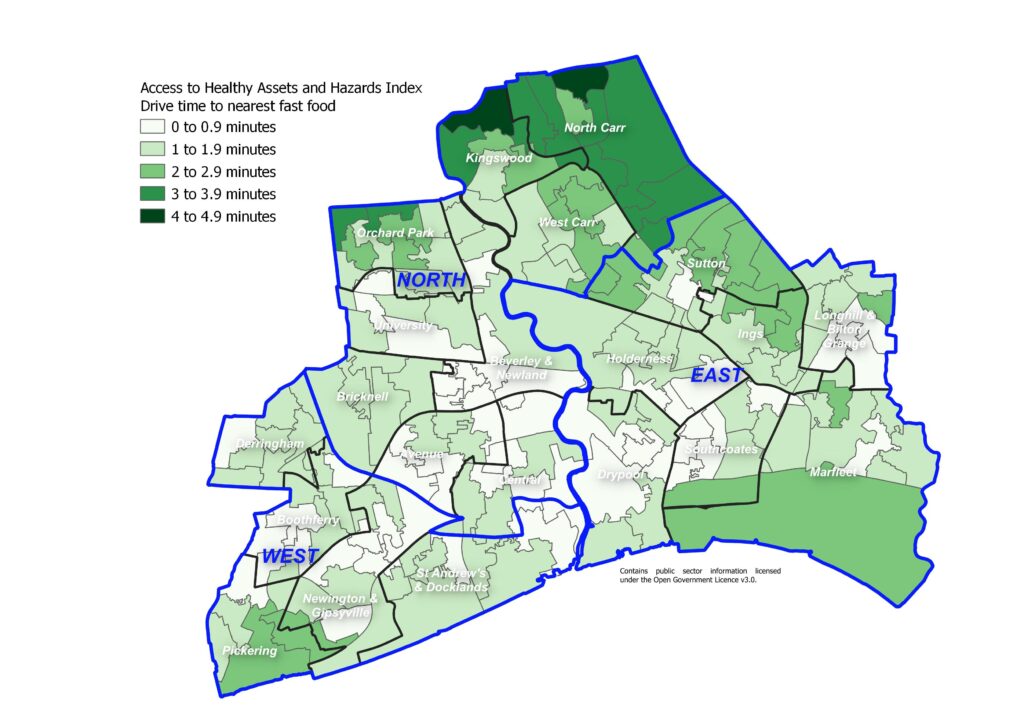
Information on the other indicators is available under Geographical Area under Place.
Free School Meals and Food Insecurity
Further information relating to children eligible for free school meals can be found under Schools, Education and Qualifications and information relating to food insecurity (concerns over being able to provide food for the family) can be found under Financial Resilience both under Health and Wellbeing Influences.
Strategic Need and Service Provision
A poor diet needs to be tackled as part of a whole–system, multifaceted approach. The local food environment and availability of food choices affects the types of food that residents can buy and this can be influenced by the Local Plan, which already includes a restriction of new food takeaways within 400 metres of a secondary school or playing field.
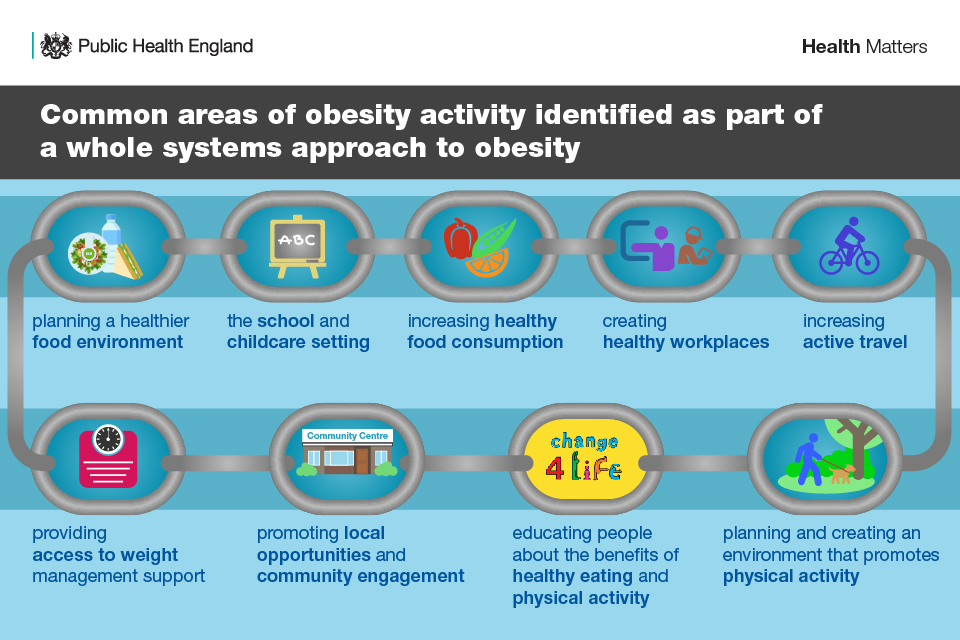
The price of food also impacts on diet and working together with the Hull Food Partnership on the Sustainable Food Cities agenda will improve access to healthy and affordable food.
Hull is recognised nationally as a bronze Sustainable Food City and is led locally by the Hull Food Partnership. The actions to achieve the award include:
- Promoting healthy and sustainable food to the public.
- Tackling food poverty, diet related ill-health and access to affordable healthy food.
- Building community food knowledge, skills, resources and projects.
- Promoting a vibrant and diverse sustainable food economy.
- Transforming catering and food procurement.
- Reducing waste and the ecological footprint of the food system.
- Developing a locally adopted Food Charter.
Services such as the Healthy Lifestyle Service provides support to families and their children via the HENRY programme and practical cooking sessions. School Nurses carry out the National Weighing and Measuring of children in reception and year 6, which helps services to support those families most at need. Interventions such as the Food for Life Programme work locally to change the food culture within schools, from the food provided, learning about nutrition, cooking in the curriculum to growing food.
Supporting national campaigns such as Change for Life and Eat Them to Defeat Them helps to get nutritional messages across in a fun interactive way.
Resources
Local Health and Wellbeing Surveys
Public Health England Fingertips: https://fingertips.phe.org.uk/
Health Survey for England: https://digital.nhs.uk/data-and-information/publications/statistical/health-survey-for-england
Active Lives, Sport England: https://activelives.sportengland.org/
Healthy Hull Adult Weight Management Service. https://www.healthyhull.org.uk/
Rayer M and Scarborough P. The burden of food related ill health in the UK. J Epidemiol Community Health, 2005;59:1054-1057.
Scarborough P, Bhatnagar P, Wickramasinghe KK, Allender S, Foster C and Rayner M. The economic burden of ill health due to diet, physical activity, smoking, alcohol and obesity in the UK: an update to 2006-07 NHS costs. Journal of Public Health, 2011;33(4):527-535.
Dimbleby H. National Food Strategy: An Independent Review for Government, 2019. https://www.nationalfoodstrategy.org/the-report/
Holmes J. Tackling obesity: the role of the NHS in a whole-system approach. The King’s Fund, July 2021. https://www.kingsfund.org.uk/sites/default/files/2021-07/Tackling%20obesity.pdf
Updates
This page was last updated / checked on 3 April 2025.
This page is due to be updated / checked in November 2025.